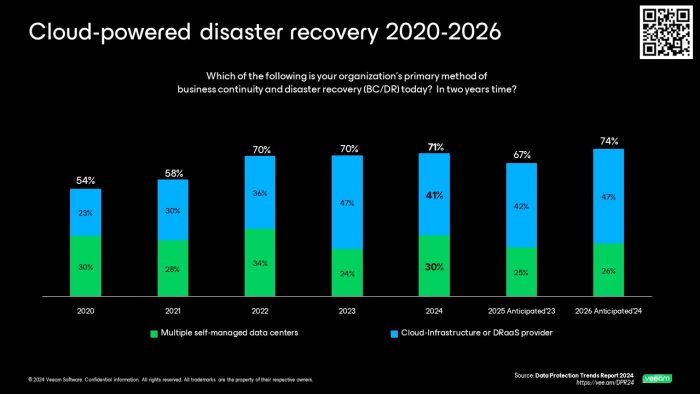
BaaS is Nearly Inevitable for Most Organizations
As part four in our deep dive coverage of the 2024 Data Protection Trends report, we’re going to take a closer look at cloud-powered data protection. The analysis below is based on the 1,200 unbiased IT leaders and implementers responsible for their enterprise organizations’ data protection strategies as surveyed in the last months of 2023.
Is 2024 the Year That the Cloud Finally Kills Tape?
NO — and cloud should not be thought of as a tape killer — just like snapshots didn’t kill backups, nor did virtualization kill physical servers, nor did the cloud kill the datacenter. Tape, like cloud-based data protection services, should be used as part of a comprehensive data protection strategy that is inclusive of the myriad reasons and methods that data restoration is as important today as it ever has been. In fact, this year’s research revealed that only 1% of the 1,200 enterprises that were surveyed do not use tape as part of their data protection and retention strategy in addition to whatever on-premises disk and or cloud-based repositories that they might also employ.
The Rise of Cloud-based Data Protection Services
That said, it is not a surprise that an increasing number of organizations are embracing the use of cloud-powered data protection beyond simply leveraging a cloud-based repository. Many organizations initially added a cloud tier to their otherwise on-premises backup solution. For Veeam customers that includes both Cloud Connect solutions that are delivered through Veeam Cloud & Service Providers (VCSPs) as well as “capacity tiers” into Azure, Amazon, or Google storage. But for many organizations, simply having a survivable copy of data in a cloud does not meet the spirit of why they first embraced cloud-powered services. For many organizations, the real value comes from the M in Managed Service Provider — i.e., the management of data protection even more so than the repository itself. The 2024 Data Protection Trends Report does draw out the usage of self-managed cloud-powered backup solutions versus managed Backup as-a-Service (BaaS), in addition to quantifying the journeys of those that started with each of those modalities as well as those that switched. Collectively, seven out of eight (88%) organizations either currently use or anticipate using backup as a service to protect at least some of their data center servers within the next two years.
Future Trends in Cloud-Powered Data Protection
Why BaaS when you can DRaaS? It is one thing to ensure that your organization does have survivable data outside of their brick walls or on-premises infrastructure, but with BaaS, the default behavior is typically to restore that data back to original or new servers as part of a retention or restoration activity. But if your data is already in a cloud host that not only provides storage but also computes on demand, then why “restore” the data? Instead, simply “power up” copies of those failed servers for the sake of disaster recovery. That insight is becoming increasingly common as seen in this year’s research. For the past five years approximately 30% of organizations have self-managed dual or multiple data centers for their disaster recovery, e.g., East Coast US to West Coast, UK to Germany, Sydney to Perth, etc. To be clear, there is a huge amount of agility that comes from this self-managed multi-datacenter approach. In fact, Veeam has been enabling this through our orchestration solution for years. However, this year’s data continues to show that the growth in an organizations ability to recover their infrastructure is increasingly likely to be using cloud infrastructure, which includes both self-managed hyperscale hosting (Azure, Amazon, Google), as well as Disaster Recovery as-a-Service (DRaaS) providers.
Integrating Data Protection With Cybersecurity
One of the most interesting evolutions of this approach is the momentum shift from BaaS to DRaaS to CRaaS — i.e., from backup, to disaster recovery, to cyber resiliency. Just as many data centers are seeing a natural — albeit sometimes forced — convergence of prevention strategies (IT security) and remediation strategies (backup/DR), that same convergence can also be seen in the managed service provider ecosystem. One presumed reason is that as MSP’s continue to gain mainstream acceptance as expanded or outsourced sources of IT, they are looking for adjacent solution areas to offer to their subscribers — e.g., security providers now offering backup or backup providers now offering detection and remediation. Pragmatically, this makes sense in that the most likely crisis that an organization is probable to face in 2024 is a cyberattack. And when, not if, that attack occurs, wouldn’t it benefit the organization to know that the same team that understands their operational IT and their prevention mechanisms also has their data to begin the recovery process?
Check out this short video that summarizes some of the key ideas described above and be sure to download the entire 2024 Data Protection Trends report.
As always, if you have questions about the research, you can find Jason and Dave on X (@JBuff and @BackupDave), LinkedIn, or you can e-mail us at StrategicResearch@veeam.com.



You must be logged in to post a comment.